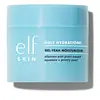What's inside
What's inside
 Key Ingredients
Key Ingredients

 Benefits
Benefits

 Concerns
Concerns

 Ingredients Side-by-side
Ingredients Side-by-side

Water
Skin ConditioningButylene Glycol
HumectantTrehalose
HumectantBis-PEG-18 Methyl Ether Dimethyl Silane
EmollientDiglycerin
HumectantSqualane
EmollientOpunta Dillenii Extract
Allantoin
Skin ConditioningSodium Hyaluronate
HumectantTocopherol
AntioxidantDipropylene Glycol
HumectantAcrylates/C10-30 Alkyl Acrylate Crosspolymer
Emulsion StabilisingArginine
MaskingHydroxyacetophenone
Antioxidant1,2-Hexanediol
Skin ConditioningDimethicone
EmollientDisodium EDTA
Parfum
MaskingGeraniol
PerfumingLinalool
PerfumingWater, Butylene Glycol, Trehalose, Bis-PEG-18 Methyl Ether Dimethyl Silane, Diglycerin, Squalane, Opunta Dillenii Extract, Allantoin, Sodium Hyaluronate, Tocopherol, Dipropylene Glycol, Acrylates/C10-30 Alkyl Acrylate Crosspolymer, Arginine, Hydroxyacetophenone, 1,2-Hexanediol, Dimethicone, Disodium EDTA, Parfum, Geraniol, Linalool
Water
Skin ConditioningCyclopentasiloxane
EmollientGlycerin
HumectantButylene Glycol
HumectantNiacinamide
SmoothingSodium Chloride
MaskingUrea
Buffering1,2-Hexanediol
Skin ConditioningCetyl PEG/PPG-10/1 Dimethicone
EmulsifyingSodium Hyaluronate
HumectantAllantoin
Skin ConditioningPolyepsilon-Lysine
Skin ConditioningDisodium EDTA
Panthenol
Skin ConditioningHydrolyzed Collagen
EmollientCollagen Water
HumectantBacillus/Soybean Ferment Extract
Skin ConditioningLactobacillus/Rye Flour Ferment
Skin ConditioningLactobacillus/Soymilk Ferment Filtrate
Skin ConditioningOctyldodecanol
EmollientPropanediol
SolventHydrogenated Lecithin
EmulsifyingCeramide NP
Skin ConditioningPentylene Glycol
Skin ConditioningCaprylyl Glycol
EmollientSodium Hyaluronate Crosspolymer
HumectantHydrolyzed Hyaluronic Acid
HumectantHyaluronic Acid
HumectantEthylhexylglycerin
Skin ConditioningFolic Acid
Skin ConditioningPantothenic Acid
Skin ConditioningPyridoxine
Skin ConditioningHydrolyzed Sodium Hyaluronate
Skin ConditioningThiamine Hcl
MaskingCyanocobalamin
Skin ConditioningRiboflavin
Cosmetic ColorantWater, Cyclopentasiloxane, Glycerin, Butylene Glycol, Niacinamide, Sodium Chloride, Urea, 1,2-Hexanediol, Cetyl PEG/PPG-10/1 Dimethicone, Sodium Hyaluronate, Allantoin, Polyepsilon-Lysine, Disodium EDTA, Panthenol, Hydrolyzed Collagen, Collagen Water, Bacillus/Soybean Ferment Extract, Lactobacillus/Rye Flour Ferment, Lactobacillus/Soymilk Ferment Filtrate, Octyldodecanol, Propanediol, Hydrogenated Lecithin, Ceramide NP, Pentylene Glycol, Caprylyl Glycol, Sodium Hyaluronate Crosspolymer, Hydrolyzed Hyaluronic Acid, Hyaluronic Acid, Ethylhexylglycerin, Folic Acid, Pantothenic Acid, Pyridoxine, Hydrolyzed Sodium Hyaluronate, Thiamine Hcl, Cyanocobalamin, Riboflavin
 Reviews
Reviews

Ingredients Explained
These ingredients are found in both products.
Ingredients higher up in an ingredient list are typically present in a larger amount.
1,2-Hexanediol is a synthetic liquid and another multi-functional powerhouse.
It is a:
- Humectant, drawing moisture into the skin
- Emollient, helping to soften skin
- Solvent, dispersing and stabilizing formulas
- Preservative booster, enhancing the antimicrobial activity of other preservatives
Allantoin is a soothing ingredient known for its protective and moisturizingg properties. Because of this, it is often added to products with strong active ingredients.
Studies show higher concentrations of this ingredient can promote wound healing.
Though it can be derived from the comfrey plant, allantoin is produced synthetically for cosmetic products to ensure purity.
Learn more about AllantoinButylene Glycol (or BG) is used within cosmetic products for a few different reasons:
Overall, Butylene Glycol is a safe and well-rounded ingredient that works well with other ingredients.
Though this ingredient works well with most skin types, some people with sensitive skin may experience a reaction such as allergic rashes, closed comedones, or itchiness.
Learn more about Butylene GlycolDisodium EDTA plays a role in making products more stable by aiding other preservatives.
It is a chelating agent, meaning it neutralizes metal ions that may be found in a product.
Disodium EDTA is a salt of edetic acid and is found to be safe in cosmetic ingredients.
Learn more about Disodium EDTASodium Hyaluronate is hyaluronic acid's salt form. It is commonly derived from the sodium salt of hyaluronic acid.
Like hyaluronic acid, it is great at holding water and acts as a humectant. This makes it a great skin hydrating ingredient.
Sodium Hyaluronate is naturally occurring in our bodies and is mostly found in eye fluid and joints.
These are some other common types of Hyaluronic Acid:
Learn more about Sodium HyaluronateWater. It's the most common cosmetic ingredient of all. You'll usually see it at the top of ingredient lists, meaning that it makes up the largest part of the product.
So why is it so popular? Water most often acts as a solvent - this means that it helps dissolve other ingredients into the formulation.
You'll also recognize water as that liquid we all need to stay alive. If you see this, drink a glass of water. Stay hydrated!
Learn more about Water